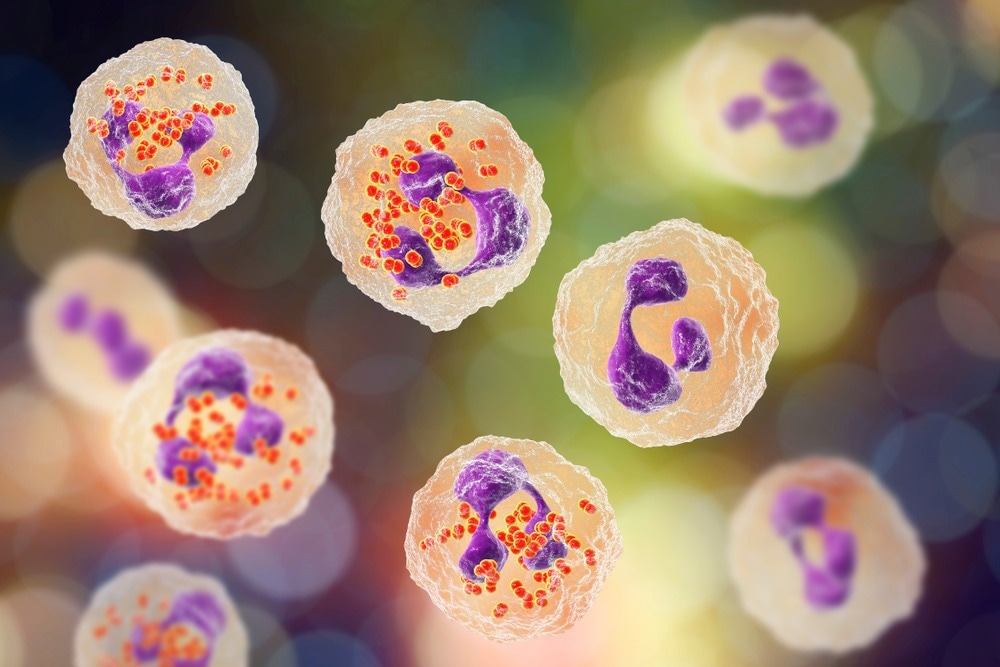In a recent study published on the medRxiv* preprint server, researchers map the proteomes of peripheral blood neutrophils isolated from hospitalized coronavirus disease 2019 (COVID-19) patients using high-resolution liquid-chromatography-mass spectrometry (LC-MS). These findings were used to provide evidence of the effects of severe acute respiratory syndrome coronavirus 2 (SARS-CoV-2) infection on neutrophil phenotypes and their functionality.

Study: Neutrophil proteomics identifies temporal changes and hallmarks of delayed recovery in COVID19. Image Credit: Kateryna Kon / Shutterstock.com

 *Important notice: medRxiv publishes preliminary scientific reports that are not peer-reviewed and, therefore, should not be regarded as conclusive, guide clinical practice/health-related behavior, or treated as established information.
*Important notice: medRxiv publishes preliminary scientific reports that are not peer-reviewed and, therefore, should not be regarded as conclusive, guide clinical practice/health-related behavior, or treated as established information.
Background
Although neutrophils are one of the primary drivers of COVID-19 pathophysiology, the molecular changes contributing to altered neutrophil phenotypes and functionality following SARS-CoV-2 infection remain unclear.
Previous studies have characterized neutrophil proteomes in COVID-19 patients with acute respiratory distress syndrome (ARDS). However, there remains a lack of studies that have systematically analyzed neutrophil proteomes in patients with COVID-19 of differing severity.
About the study
In the present study, researchers comprehensively quantified and mapped changes in more than 1,700 proteins in neutrophils isolated from 200 individuals with varying COVID-19 severity. The patients of the study cohort were hospitalized due to COVID-19 between May 2020 and December 2020, with samples obtained up to 29 days following hospitalization.
The two control cohorts matched the test cohort based on age and gender; however, these patients also had lower respiratory tract infections (LRTIs) that were not due to SARS-CoV-2.
Baseline COVID-19 severity was assessed according to the World Health Organization (WHO) scale. At the end of the study, patients were classified as recovered or non-recovered, with a WHO score of one indicating recovery and two to three indicating non-recovery.
Peripheral blood mononuclear cells (PBMCs), and neutrophil pellets were used for LC-MS analysis. Differential expression gene (DEG) analyses were performed in R software v 4.0.3. to calculate the global p-values and fold changes.
A q-value of less than 0.05 indicated significant differences in global protein levels assessed by the Bioconductor package q-value. Likewise, global p-values were calculated for protein families and PBMC proteins using Welches T-test, with p-values of less than 0.05 being statistically significant.
Study findings
The neutrophil proteomes of non-recovered patients exhibited a systematic reduction in several migratory receptors, ranging from cytokine and complement receptors to sphingosine-1-phosphate receptors. The dysfunctional phenotype of post-COVID-19 neutrophils was dependent on signaling receptors and integrins to recognize migratory signals and perform the leucocyte extravasation process.
A marked reduction in the abundance of macrophage-1 (Mac-1) subunits and lymphocyte function-associated antigen-1 (LFA-1) complexes that mediate leucocyte extravasation was observed.
Regardless of disease severity, most neutrophil proteomes derived from COVID-19 patients had a core COVID-19 signature. Notably, this signature was sometimes transient with divergent kinetics and depended on COVID-19 severity. Nevertheless, it defined the scope for stratified therapeutic interventions against COVID-19.
The authors also identified the pattern recognition receptor, such as the toll-like receptor 2, and the V-domain immunoglobulin suppressor of T-cell activation (VISTA), an inhibitory receptor, as novel markers of COVID-19 severity.
Several studies have reported correlations of high VISTA levels on neutrophils with severe COVID-19; thus, this receptor could be a potential target against excessive activation of innate immunity.
Neutrophils of COVID-19 patients with moderate disease severity had sustained interferon (IFN) protein signatures, whereas, for those with severe COVID-19, this signature rapidly returned to normal levels that were similar to controls.
A reduction in glycogenolysis was observed at all study time points. Additionally, metabolic changes associated with COVID-19 severity, such as lactate dehydrogenase A levels linked to hypoxia, were observed.
Studies on multiple sclerosis (MS) patients have shown that a lateral flow test could monitor myxovirus resistance protein 1 (MX1), a marker for IFN-I activity in MS patients. A similar method could identify critically ill COVID-19 patients unable to mount an IFN-I response who could also benefit from IFN-β treatment.
When the environment is nutrient-rich, neutrophils depend on glycolysis for energy production, while these immune cells use glycogen breakdown when the environment is nutrient-deficient. The present study revealed that the neutrophil proteomes of non-recovered patients had a significantly reduced abundance of proteins that limit the rates of glycolysis and glycogenolysis pathways. This finding indicated an impaired bioenergetic capacity of neutrophils, which, in turn, suggests impaired neutrophil survival capacities during chronic illnesses.
Conclusions
In conclusion, the current study identified distinct neutrophil receptors linked to COVID-19 severity that could serve as potential therapeutic targets. Future studies should focus on a more detailed characterization of a molecular phenotype linked to delayed COVID-19 recovery and persistent symptoms of COVID-19.

 *Important notice: medRxiv publishes preliminary scientific reports that are not peer-reviewed and, therefore, should not be regarded as conclusive, guide clinical practice/health-related behavior, or treated as established information.
*Important notice: medRxiv publishes preliminary scientific reports that are not peer-reviewed and, therefore, should not be regarded as conclusive, guide clinical practice/health-related behavior, or treated as established information.
Journal reference:
- Preliminary scientific report.
Long, M. B., Howden, A. J. M., Keir, H. R., et al. (2022). Neutrophil proteomics identifies temporal changes and hallmarks of delayed recovery in COVID19. medRxiv doi:10.1101/2022.08.21.22279031. https://www.medrxiv.org/content/10.1101/2022.08.21.22279031v1 .